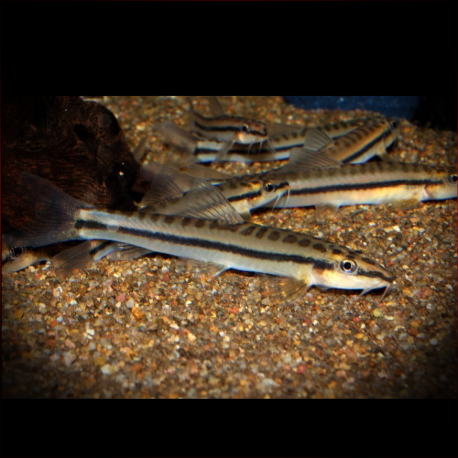More info
Datasheet
| Minimum Tank Size | 60 litres / 15.85 US gallons |
| Maximum Size | 7.0cm / 2.76inches |
| Temperature | 23°C / 73.40°F - 26°C / 78.80°F |
| Hardness | 2.02dgH / 36ppm - 12.05dgH / 215ppm |
| pH | 6.0-7.5 |
General Description
The Nemacheilus Masyae, commonly known as the Arrow Loach, has a slender body with distinct body patterning characterized by dark vertical bars on each flank and saddle-like markings along the dorsal surface. It can be differentiated from similar species by various physical traits such as body proportions and markings. Belonging to the Cypriniformes order, these loaches are peaceful with conspecifics and prefer being kept in groups.
Aquarium Setup
To mimic the natural habitat of the Arrow Loach, it is recommended to set up an aquarium resembling a flowing stream or river. The tank should have a substrate of rocks, sand, fine gravel, and water-worn boulders, with driftwood branches creating hiding spots. Hardy aquatic plants like Microsorum, Bolbitis, or Anubias can be added. Maintaining high oxygen levels and moderate water movement is crucial, achieved through power filters, powerheads, or airstones. Regular 30-50% water changes are essential for water quality.
Behaviour
Arrow Loaches thrive when housed with peaceful, open water-dwelling cyprinids, preferring to be in a group of four or more. They are peaceful with conspecifics but may become territorial or aggressive with certain species. The presence of other compatible fish helps boost their confidence, as they are naturally reclusive. Their behavior can vary based on the presence of suitable tank mates.
Feeding and Diet
Nemacheilus species are omnivorous, primarily feeding on small insects, worms, crustaceans, and zooplankton. In the aquarium, they accept dried foods but should be supplemented with live or frozen options like Daphnia, Artemia, and bloodworms for optimal coloration and health. A varied diet rich in protein is essential to their well-being.
Reproduction & Dimorphism
Limited information is available on the reproduction of the Arrow Loach. Mature males exhibit distinctive features like a suborbital flap and thickened pectoral-fin rays with small tubercules. Adult females tend to be slightly larger and heavier-bodied than males. Further studies may provide more insights into their reproductive behavior.
Habitat and Distribution
The Arrow Loach is native to freshwater habitats in southern Thailand and parts of Peninsular Malaysia. It is found in small blackwater forest streams and turbid main river channels with mud, sand, or small rock substrates. These loaches coexist with various fish species in their natural habitats, showcasing adaptability to diverse aquatic environments.

